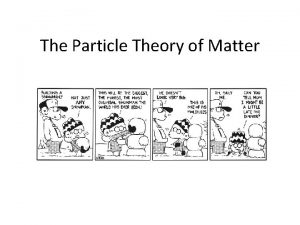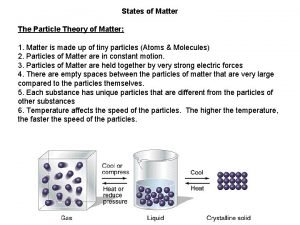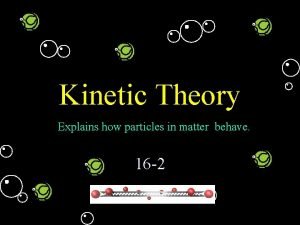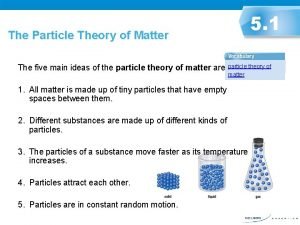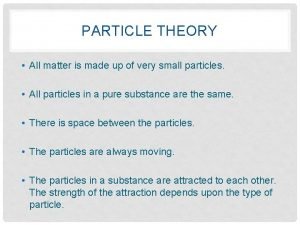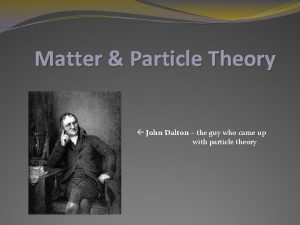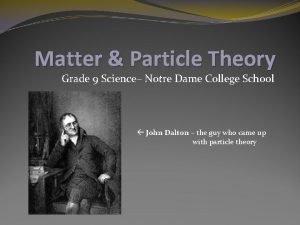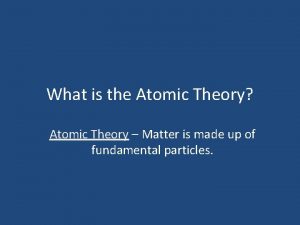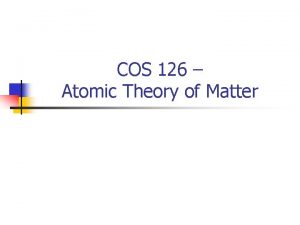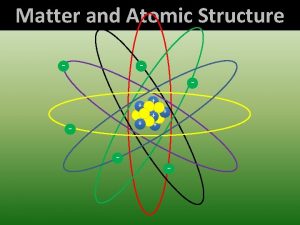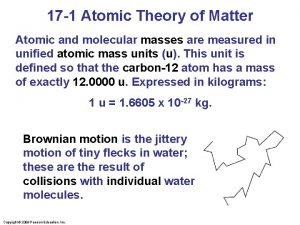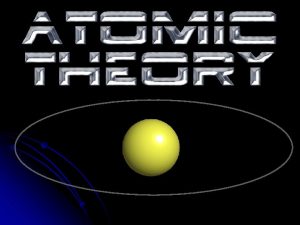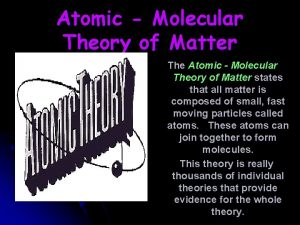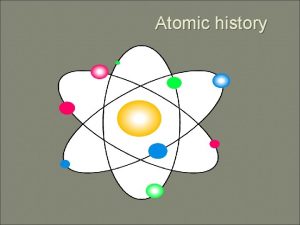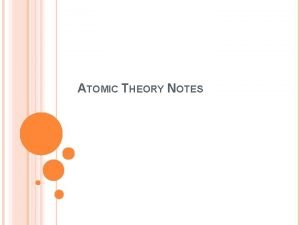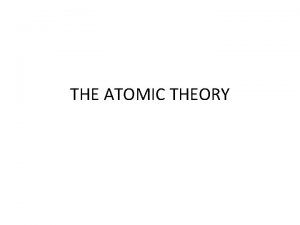What is the Atomic Theory Atomic Theory Matter





























































![Practice w/ Abbreviated e- Config. • Calcium [Ar]4 s 2 • Selenium [Ar]4 s Practice w/ Abbreviated e- Config. • Calcium [Ar]4 s 2 • Selenium [Ar]4 s](https://slidetodoc.com/presentation_image_h2/30f7512054a29a2452abe60255118357/image-62.jpg)






- Slides: 68

What is the Atomic Theory? Atomic Theory – Matter is made up of particles.

Early Thoughts • Scientists were aware that matter is made up of small particles. • But originally, they thought the atom was “indivisible”! (Basically just little spheres that could not be broken down. ) • Now – We know the atom is made up of smaller particles (subatomic particles).

Rutherford’s Gold Foil Experiment


To better understand how significant Rutherford’s work was… • If an atom was the size of a football field, the nucleus would be the size of a green pea on the 50 yard line.

The craziest part… • ALL the mass of the entire atom is only in that little, tiny nucleus!!!! • Why? – Electrons weigh pretty much NOTHING!!!

Here’s what you need to remember: Ø When Rutherford shot alpha particles at gold foil: 1) Most of the alpha particles went straight through the foil… Atoms are mostly empty space. 2) A few bounced back… Small, dense positively-charged nucleus. Ø Nucleus: small, dense core containing protons and neutrons. Ø Electrons surround the nucleus.

Subatomic Particles Particle Symbol Relative Charge Relative Location Mass in atom nucleus 1 Proton p+ 1+ Neutron no 0 1 Electron e- 1 - 1/2000 ~0 Notice that only neutrons and protons have mass! nucleus outside nucleus

Parts of an atom – DRAW IT! Nucleus

The NUCLEUS • • Located at the center of the atom. Takes up ALL the mass of atom. Contains protons (+) and neutrons (0). Electrons surround it.

Atomic Number – “Z” • # of protons • THIS IDENTIFIES THE ELEMENT!!! – What makes carbon atom? 6 protons! – What happens if you take away a proton from carbon? It becomes boron!! (5 protons) • The atomic numbers are on the periodic table.

Atomic Theory Timeline https: //www. youtube. com/watch? reload=9&v=NSAg. Lv. KOPLQ

Neutral Atoms • In a neutral atom, # of protons = # of electrons • Why does it make sense that p+ and e- would be equal if the atom is neutral? – The (+) charges from the protons would have to balance the (-) charges from the electrons.

Ions • Ion: formed when an atom gains or loses an ELECTRON and becomes charged. • Note: Opposite of what you think!! – Gained an electron (-) charge – Lost an electron (+) charge

Ions (cont’d) 1+ Examples: Na lost 1 electron 2 S gained 2 electrons To find # of electrons, start with # of protons and do opposite what the charge says. Practice: Find the number of e- for each: 1) Ca 2+ 2) F 1 - 3) Na 1+ 4) P 3 -

Mass Number – “A” • Mass = (# of protons) + (# of neutrons) Most of the mass of the atom is concentrated in the nucleus. (Electrons don’t really weigh anything. )

Isotope Symbol Mass Number (#P + #N) 9 4 Atomic Number (#P) Be

To find the number of neutrons in an atom… • # neutrons = (mass number) – (atomic number)

How many protons and neutrons are found in the nucleus of these atoms? 1. Na 23 11 2. S 32 16 3. Ag 108 47 207 82 4. Pb 5. Carbon-14 6. Fluorine-19 7. Chromium-52

How many protons and neutrons are found in the nucleus of these atoms? p = 11 n = 12 23 1. Na 11 P = 16 n = 16 2. S 32 16 108 47 207 82 3. Ag P = 47 n = 61 4. Pb P = 82 n = 125 5. Carbon-14 6. Fluorine-19 7. Chromium-52 P=6 n=8 P=9 n = 10 P = 24 n = 28

Mass # and The Periodic Table • Note – If you are not given a mass number, you can round the atomic mass on the periodic table to the nearest whole number…


Isotopes • Isotopes – atoms that have the same # protons, but different # neutrons. • Different mass numbers b/c different # neutrons. • Ex. carbon-12, carbon-14 * Both have 6 p+ * One has 6 n 0 and the other has 8 n 0

Isotope Examples Example: How many protons, neutrons, & electrons? Ne-20: ___ p+, ____ e-, ____no Ne-21: ___ p+, ____ e-, ____no Ne-22: ___ p+, ____ e-, ____no

Isotope Examples Example: How many protons, neutrons, & electrons? Ne-20: _10__ p+, _10___ e-, _10__no Ne-21: _10__ p+, _10__ e-, _11__no Ne-22: _10__ p+, _10___ e-, _12__no

Average Atomic Mass • Average atomic mass – the average of all the naturally occurring isotopes of that element. – These are listed on the periodic table. – Units: grams/mole or amu

Difference btwn Average Atomic Mass and Mass Number Average Atomic Mass • Average of all the isotopes in the world • Long decimal • Found on Per. Tble. Mass Number • Mass of just 1 atom • Whole number • Either given to you or you can round the avg. atomic mass on the per. tble.

“Average Atomic Mass” vs. “Mass Number” • On the periodic table, the average atomic mass of lithium is 6. 941 g/mol. • If I tell you I have a lithium atom with a mass of 8 g/mol, is that possible?

Average Atomic Mass from Relative Abundance • To calculate average from relative abundance: 1) Multiply the percent (in decimal form) by each mass. 2) Add all masses together. Example: Calculate the average atomic mass of the following sample of carbon: 98. 892% carbon-12 1. 108% carbon-13 (0. 98892 x 12) + (0. 0108 x 13) = 12. 011 amu

Average Atomic Mass Example • Calculate the average atomic mass of the following sample: 90. 51% neon-20 0. 27% neon-21 9. 22% neon-22 (0. 9051 x 20) + (0. 0027 x 21) + (0. 0922 x 22) = 20. 18 amu

Preview to the Periodic Table • Organized by increasing atomic number. • Period = horizontal row • Group or Family = vertical column (Helpful Hint – Think of a “family tree”…and trees grow up/down. )

Bohr’s Planetary Model, 1913 • Electrons move in circular paths (orbits) around the positive nucleus. • Planetary model - Like planets around a sun

Bohr used experiments on hydrogen to develop this model: 1) An electron circles the nucleus only in fixed energy levels (like an orbit). 2) An electron can neither gain nor lose energy within the orbit…but it can move up or down to different orbits. 3) The lowest energy orbit is closets to the nucleus.

Energy Levels • Energy Levels - Regions of space in which e- can move around the nucleus of an atom. – “Rings around the nucleus where e- exist. ” • Ground State – closest possible E. L. to the nucleus. • Excited State – If given a quantum (packet of energy), e- can move to a higher E. L. (farther from nucleus). This state is unstable!

Bohr’s Model * Think of it like a circular ladder. * It takes energy to climb up the ladder (away from the nucleus) * The higher you go, the more energy it takes & the more unstable it is. * Notice the rings get closer together as you move out…

How an Emission Spectrum is Produced 1) An e- starts in ground state. 2) It can gain energy and move to an excited state. 3) But then it is unstable, so it returns to ground state…and in the process, gives off the energy it received. Emission Spectrum

Emission Spectra • When an electron moves to a lower energy level, it releases an amount of energy equal to the energy difference in these levels as electromagnetic radiation - Emission Spectrum • This electromagnetic radiation is given off as photons - quanta or packets of light

Emission Spectra – No 2 elements have the same emission spectrum (because they each have a unique set of e-). – The farther the electron falls, the greater the amount of energy released.

The Real World • What is a real world application of giving electrons energy and then having them return to ground state?

Using the Reference Table 1) What wavelength is given off when an electron moves from the 3 rd energy level to the 1 st? What type of radiation is it? 2) What color light is released when an electron moves from the 4 th energy level to the 2 nd? 3) What wavelength could be given off if you see red light?

Electromagnetic Spectrum • Electromagnetic radiation energy waves that have both electrical and magnetic properties. • Can travel through empty space at c = 3 x 108 m/s (the speed of light).

Wave/Particle duality of electrons • Which one is it? BOTH – Electrons act like a particle – But they behave like waves!!

Wavelength, Frequency, Energy Wavelength (λ) – distance from peak to peak. Frequency – number of peaks per second. Crest – Top peak of the wave. Trough – Bottom of the wave. Wavelenth trough crest

Relationships wavelength – frequency Indirectly related wavelength – energy Indirectly related frequency – energy Directly related

Electromagnetic Spectrum • Low Energy, Low Frequency, Long Wavelength 1. 2. 3. 4. Radio Waves (AM, FM, TV) Microwaves (cell phones, microwave ovens) Infrared (given off as heat) Visible Light (ROYGBIV: Red is the lowest energy, violet has the highest) 5. Ultraviolet (causes sunburns) 6. X-rays (can pass through body, except bones) 7. Gamma Rays (can pass through 3 meters of concrete) • High Energy, High Frequency, Short Wavelength

Quantum Model • Schrodinger • Cannot pinpoint the exact paths of electrons (only probability!!!). • Probability of finding an electron is represented by an electron cloud.

Overall Progression of the Atom

• http: //ed. ted. com/lessons/the-uncertainlocation-of-electrons-george-zaidan-andcharles-morton

Quantum Numbers • Quantum Numbers - Values that give the most probable place to find an electron. • Like an “electron’s address”. • No 2 electrons in an atom can have the same quantum numbers.

First Quantum Number • Energy Levels – cloud SIZE – (Rings around the nucleus) – Corresponds to horizontal rows on the periodic table.

Second Quantum Number • Sublevels – SHAPE – There are four: s (sphere) p (peanut) d (double peanut) f (? ) - They correspond to areas of the periodic table. - Energy level tells the number of sublevels. Ex. In the 1 st energy level, you can have 1 sublevel s In the 2 nd energy level, you can have 2 sublevels s & p

Third Quantum Number • Orbitals – DIRECTION (Orientation) – Two electrons can fit in one orbital. # orbitals # electrons s p d f 1 3 5 7 2 6 10 14

Fourth Quantum Number • Spin – 2 electrons in the same orbital MUST have opposite spins. – Based on Pauli’s Exclusion Principle

Quantum Number Practice Number of Electrons per Sublevel Energy Level 1 2 3 4 Number of Sublevels Sublevel Names s p d f Max # of Electrons per Energy Level

Quantum Numbers Practice Number of Electrons per Sublevel Energy Level Number of Sublevels Sublevel Names s 1 1 s 2 2 2 s, p 2 6 3 3 s, p, d 2 6 10 4 4 s, p, d, f 2 6 10 p d f Max # of Electrons per Energy Level 2 8 18 14 32

Electron Configuration • Electron Configuration – The most stable arrangement of electrons in sublevels and orbitals.

3 Things about e- Configurations • Aufbau Principle – “Building up” – Electrons occupy the lowest energy level available. • Pauli’s Exclusion Principle – “Different addresses” – If 2 electrons are in the same orbital, they HAVE to have opposite spins. • Hund’s Rule – “Fair share” – Each orbital in a sublevel MUST have 1 electron before any orbital in that sublevel receives a 2 nd.

Format of e- Configurations “Exponents” tell how many electrons are in that region of space Oxygen: 2 2 4 1 s 2 s 2 p Coefficients tell the energy level (distance from the nucleus Letters tell the sublevel (shape) of the orbital


Practice: Writing e- Configurations • Carbon – 1 s 22 p 2 • Argon – 1 s 22 p 63 s 23 p 6 • Fluorine – 1 s 22 p 5 • Germanium – 1 s 22 p 63 s 23 p 64 s 23 d 104 p 2 • Potassium – 1 s 22 p 63 s 23 p 64 s 1

Abbreviated Electron Configuration • • • Helium Lithium Carbon Neon Sodium Scandium 1 s 2 [He]2 s 1 [He]2 s 22 p 2 [He]2 s 22 p 6 = [Ne]3 s 1 [Ar]4 s 23 d 1
![Practice w Abbreviated e Config Calcium Ar4 s 2 Selenium Ar4 s Practice w/ Abbreviated e- Config. • Calcium [Ar]4 s 2 • Selenium [Ar]4 s](https://slidetodoc.com/presentation_image_h2/30f7512054a29a2452abe60255118357/image-62.jpg)
Practice w/ Abbreviated e- Config. • Calcium [Ar]4 s 2 • Selenium [Ar]4 s 23 d 104 p 4 • Strontium [Kr]5 s 2 • Magnesium [Ne]3 s 2 • Cobalt [Ar]4 s 23 d 7 • Americium [Rn]7 s 25 f 6 • Lead [Xe]6 s 24 f 145 d 106 p 2

Electron Configurations of Ions • If you are given an ion (w/ a charge), first write the e- config. for the neutral atom. • Then add (if -) or take away (if +) e- as needed. Note: remove e- from the highest orbital (biggest coefficient) first! Ex. Write the electron configuration for S 2 -. First – 1 s 22 p 63 s 23 p 4 Then think about the charge: 2 - means you need to add 2 more electrons. They can be put in the 3 p orbital (b/c it can hold up to 6 e-). 1 s 22 p 63 s 23 p 6

Practice: e- configurations of ions • Write the electron configuration for each: (You can abbreviate. ) – Mg 2+ [Ne] – Cl- [Ne] 3 s 23 p 6 – Ni+ [Ar] 4 s 13 d 8 – O 2 - [He] 2 s 22 p 6

Orbital Notation • Use boxes and arrows to show electron configurations. • Don’t forget “opposite spins” and “fair share” rules! • Example: Sulfur [Ne]3 s 23 p 4 3 s 2 3 p 4

Practice with Orbital Notation First write the abbreviated e- configuration for each. Then draw the orbital notations. 1) Si [Ne]3 s 23 p 2 2) As [Ar]4 s 23 d 104 p 3 3) Sr [Kr]5 s 2

Valence Electrons • Valence Electrons – electrons in the outermost energy level – Determines the chemical and physical properties of elements!! – Use the periodic table to figure out the number of valence e-. – Exception – All noble gases have 8 valence electrons EXCEPT helium, which has 2. – “D” and “F” block elements usually have 2 valence electrons

Practice with Valence e • Determine the # of valence e- for each: – Silicon – Bromine – Aluminum – Antimony (Sb) – Cesium
 Classification of matter section 1 composition of matter
Classification of matter section 1 composition of matter What is white matter made of
What is white matter made of Classification of matter section 1 composition of matter
Classification of matter section 1 composition of matter Chapter 2 matter section 1 classifying matter answer key
Chapter 2 matter section 1 classifying matter answer key Median and lateral apertures
Median and lateral apertures Composition of matter section 1
Composition of matter section 1 Gray matter and white matter
Gray matter and white matter Frontal and parietal lobes
Frontal and parietal lobes Flow of energy vs flow of matter
Flow of energy vs flow of matter Is atomic mass and relative atomic mass the same
Is atomic mass and relative atomic mass the same Periodic trends
Periodic trends Ionic radius trend
Ionic radius trend Mass of oxygen
Mass of oxygen Difference between atomic number and atomic mass
Difference between atomic number and atomic mass Atomic number vs atomic radius
Atomic number vs atomic radius Hát kết hợp bộ gõ cơ thể
Hát kết hợp bộ gõ cơ thể Frameset trong html5
Frameset trong html5 Bổ thể
Bổ thể Tỉ lệ cơ thể trẻ em
Tỉ lệ cơ thể trẻ em Chó sói
Chó sói Glasgow thang điểm
Glasgow thang điểm Hát lên người ơi alleluia
Hát lên người ơi alleluia Các môn thể thao bắt đầu bằng tiếng chạy
Các môn thể thao bắt đầu bằng tiếng chạy Thế nào là hệ số cao nhất
Thế nào là hệ số cao nhất Các châu lục và đại dương trên thế giới
Các châu lục và đại dương trên thế giới Công thức tính độ biến thiên đông lượng
Công thức tính độ biến thiên đông lượng Trời xanh đây là của chúng ta thể thơ
Trời xanh đây là của chúng ta thể thơ Cách giải mật thư tọa độ
Cách giải mật thư tọa độ 101012 bằng
101012 bằng Phản ứng thế ankan
Phản ứng thế ankan Các châu lục và đại dương trên thế giới
Các châu lục và đại dương trên thế giới Thơ thất ngôn tứ tuyệt đường luật
Thơ thất ngôn tứ tuyệt đường luật Quá trình desamine hóa có thể tạo ra
Quá trình desamine hóa có thể tạo ra Một số thể thơ truyền thống
Một số thể thơ truyền thống Cái miệng bé xinh thế chỉ nói điều hay thôi
Cái miệng bé xinh thế chỉ nói điều hay thôi Vẽ hình chiếu vuông góc của vật thể sau
Vẽ hình chiếu vuông góc của vật thể sau Biện pháp chống mỏi cơ
Biện pháp chống mỏi cơ đặc điểm cơ thể của người tối cổ
đặc điểm cơ thể của người tối cổ Thế nào là giọng cùng tên?
Thế nào là giọng cùng tên? Vẽ hình chiếu đứng bằng cạnh của vật thể
Vẽ hình chiếu đứng bằng cạnh của vật thể Fecboak
Fecboak Thẻ vin
Thẻ vin đại từ thay thế
đại từ thay thế điện thế nghỉ
điện thế nghỉ Tư thế ngồi viết
Tư thế ngồi viết Diễn thế sinh thái là
Diễn thế sinh thái là Các loại đột biến cấu trúc nhiễm sắc thể
Các loại đột biến cấu trúc nhiễm sắc thể Bảng số nguyên tố lớn hơn 1000
Bảng số nguyên tố lớn hơn 1000 Tư thế ngồi viết
Tư thế ngồi viết Lời thề hippocrates
Lời thề hippocrates Thiếu nhi thế giới liên hoan
Thiếu nhi thế giới liên hoan ưu thế lai là gì
ưu thế lai là gì Hổ đẻ mỗi lứa mấy con
Hổ đẻ mỗi lứa mấy con Khi nào hổ mẹ dạy hổ con săn mồi
Khi nào hổ mẹ dạy hổ con săn mồi Sơ đồ cơ thể người
Sơ đồ cơ thể người Từ ngữ thể hiện lòng nhân hậu
Từ ngữ thể hiện lòng nhân hậu Thế nào là mạng điện lắp đặt kiểu nổi
Thế nào là mạng điện lắp đặt kiểu nổi Particle theory of matter
Particle theory of matter Chemical equation states of matter
Chemical equation states of matter The kinetic theory of matter states that
The kinetic theory of matter states that Kinetic theory of matter definition
Kinetic theory of matter definition Kinetic theory of matter
Kinetic theory of matter An explanation of how particles in matter behave
An explanation of how particles in matter behave Define particle theory of matter
Define particle theory of matter Particle theory of matter
Particle theory of matter Particle theory of matter
Particle theory of matter Particle theory of matter
Particle theory of matter Pure substance vs element
Pure substance vs element Particle theory dissolving
Particle theory dissolving

























































